Episodes

Sunday Apr 03, 2022
Sunday Apr 03, 2022
The two Mongol-Yuan invasions of Japan (1274 and 1281) were important events in Japanese history. The two typhoons that destroyed the Mongol fleet, known as "divine wind," (shinpū 神風, better known today as kamikaze) would forever be etched into Japanese historical memory, directly influencing the so-called kamikaze suicide bombers of World War II. Most scholarship on the topic has focused primarily on the military aspect, but before and after the invasions there was also an intense diplomatic effort behind the scenes involving the Mongol-Yuan, Kamakura Japan, and Koryŏ Korea in an attempt to integrate Japan peacefully into the Mongol world order. In this episode, Greg speaks to USC PhD candidate Lina Nie about her dissertation research on this diplomatic effort. Lina will share with us some new perspectives on why the Mongols wanted to engage and ultimately invade Japan, what the diplomatic negotiations can tell us about the interstate order of East Asia during that time, and how her research both complements existing scholarship and adds a new layer in our understanding of the Mongol invasions of Japan.
Contributors
Lina Nie

Lina Nie is a Ph.D. candidate in the Department of History at the University of Southern California. She graduated from the Hong Kong University with double majors in Chinese History and Japanese Studies and received her MA from Harvard University. Her research interests are on maritime, diplomatic, military, and cultural exchanges among China, Korea, and Japan. She is also interested in global history and comparative history in a broader geographical context that goes beyond East Asia. Her Japanese article discussing the traditions of Japanese culture won the second runner-up in the annual essay contest held by the Japanese Consulate General in New England in 2017.
Greg Sattler
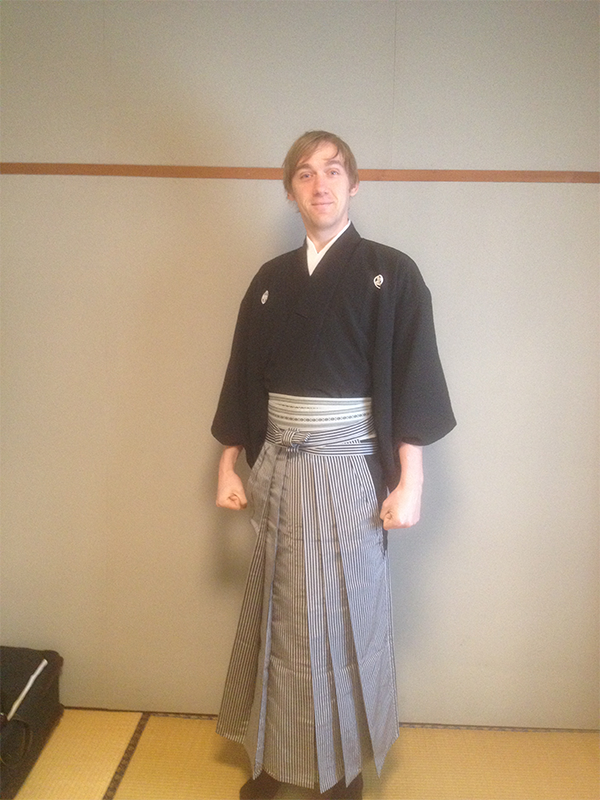
Gregory Sattler is a Ph.D. student in the Department of History at the University of California, Los Angeles. His research focuses on sea merchants in East Asia from the ninth to thirteenth centuries, with a particular consideration of their place in society, their trade networks, and their relationships with government officials. Gregory has recently published an article titled “The Ideological Underpinnings of Private Trade in East Asia, ca. 800–1127” (Journal of Asian Humanities at Kyushu University 6) and he is currently working on two additional manuscripts. He has received degrees in Taiwan and Japan, and is a proficient speaker of both Chinese and Japanese.
Credits
Episode no. 10
Release date: April 3, 2022
Recording location: Los Angeles, CA
Bibliography courtesy of Lina Nie
Images

Cover Image: The famous battle scene depicting the samurai Takezaki Suenaga escaping the Mongol forces. (Image Source)
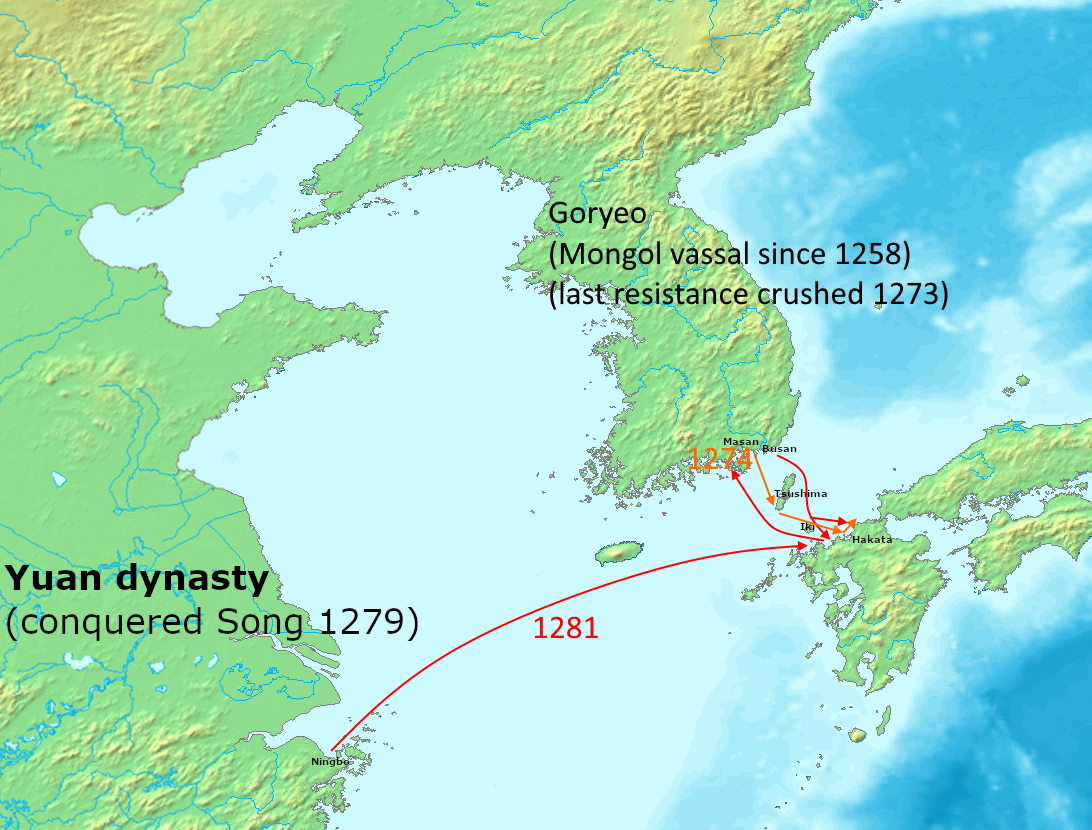
Map of the two Mongol invasions. (Image Source)
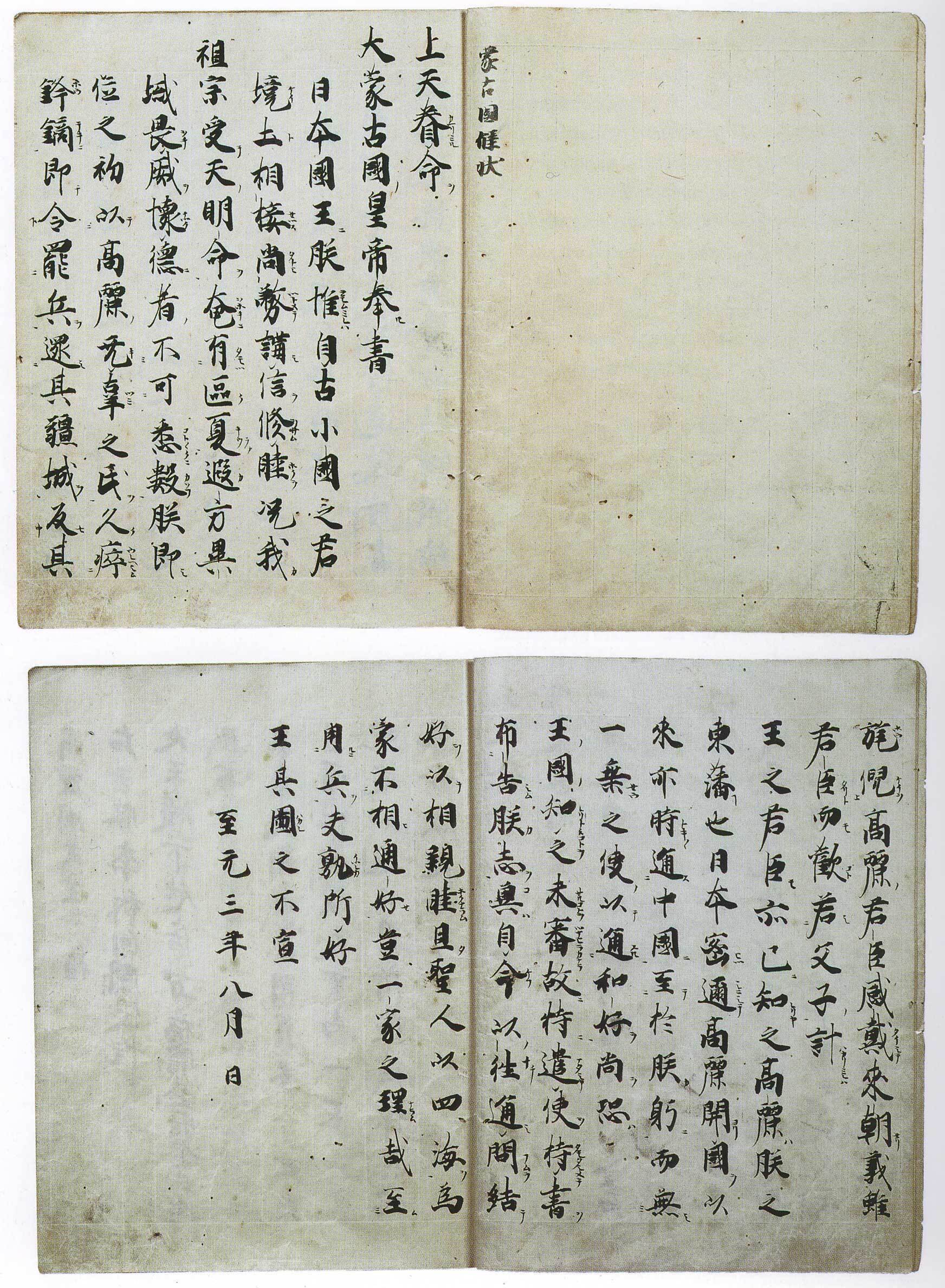
A 1266 letter Khubilai sent to Japan. (Image Source)

Japanese samurai boarding a Yuan ship during the 1281 invasion. (Image Source)
References
Andrade, Tonio. The Gunpowder Age: China, Military Innovation, and the Rise of the West in World History. New Jersey: Princeton University Press, 2016.
Conlan, Thomas. In Little Need of Divine Intervention: Takezaki Suenaga’s Scrolls of the Mongol Invasions of Japan. Ithaca: Cornell University, 2001.
Fukuokashi maizō bunka zai 福岡市埋蔵文化財年報. Ed. Fukuokaken Kyoiku Iinkai福岡県教育委員会, vol. 274, 2019.
Kamakura ibun鎌倉遺文. Ed. Takeuchi Rizō竹内理三. Tokyo: Tōkyōdō Shuppan, 2008.
Cambridge History of Japan: Medieval Japan (vol. 3), eds. John Hall, Marius Jansen, Madoka Kanai, and Denis Twitchett. Cambridge: Cambridge University, 1990.
Kim Gu 金坵. Chipojip 止浦集. Han’guk munjip ch’onggan 韓國文集叢刊. Seoul: Minjok Munhwa Ch’ujinhoe, 1991.
Kuraki kaitei iseki hakkutsu chōsa gaihō 倉木崎海底遺跡発掘調査概報. Ed. Ukenson Kyoiku Iinkai宇検村教育委員会. 1993.
Mass, Jeffery. Yoritomo and the Founding of the Kamakura Bakufu. Stanford: Stanford University Press 1995.
Robinson, David. Empire’s Twilight: Northeast Asia Under the Mongols. Cambridge, MA: Harvard Yenching Monograph, 2009.
Cambridge History of China vol.6: Alien Regimes and Border States, eds. Herbert Franke and Denis Twitchett. Cambridge: Cambridge University, 1994.
Rossabi, Morris. Khubilai Khan: His Life and Times. Berkeley: University of California Press, 2009.
Shultz, Edward. Generals and Scholars: Military Rule in Medieval Korea. Honolulu: University of Hwaii Press. 2000.
Wang, Sixiang. “What Tang Taizong Could Not Do: The Korean Surrender of 1259 and the Imperial Tradition.” T'oung Pao (2018), pp.338-383.
Yamauchi Shinji 山内晋次. Nichisō bōeki to iō no michi 日宋貿易と「硫黄の道」.Tokyo: Yamakawa Shuppansha, 2009.

Sunday Feb 13, 2022
Sino-Japanese Diplomatic Encounters from the 1st to the 9th Century
Sunday Feb 13, 2022
Sunday Feb 13, 2022
In this prequel to our first interview, UCLA Ph.D. student Greg Sattler talks about the diplomatic/tribute embassies that peoples and polities from the Japanese Archipelago dispatched to China from the 1st to the 9th centuries. While Japanese tribute embassies to China mainly evoke the missions that Japan dispatched to Tang China in the 8th and 9th centuries, diplomacy between China and Japan had been going on well before then. Greg talks about the evidence for these earlier embassies, why they happened, the role of the Korean Peninsula in facilitating exchange, why the Japanese decided to dispatched embassies to learn from Tang China, and why these embassies stopped in the late 9th century.
Contributors
Greg Sattler

Gregory Sattler is a Ph.D. student in the Department of History at the University of California, Los Angeles. His research focuses on sea merchants in East Asia from the ninth to thirteenth centuries, with a particular consideration of their place in society, their trade networks, and their relationships with government officials. Gregory has recently published an article titled “The Ideological Underpinnings of Private Trade in East Asia, ca. 800–1127” (Journal of Asian Humanities at Kyushu University 6) and he is currently working on two additional manuscripts. He has received degrees in Taiwan and Japan, and is a proficient speaker of both Chinese and Japanese.
Yiming Ha

Yiming Ha is a Ph.D. candidate in the Department of History at the University of California, Los Angeles. His current research is on military mobilization and state-building in China between the thirteenth and seventeenth centuries, focusing on how military institutions changed over time, how the state responded to these changes, the disconnect between the center and localities, and the broader implications that the military had on the state. His project highlights in particular the role of the Mongol Yuan in introducing an alternative form of military mobilization that radically transformed the Chinese state. He is also interested in military history, nomadic history, comparative Eurasian state-building, and the history of maritime interactions in early modern East Asia. He received his BA from UCLA and his MPhil from the Hong Kong University of Science and Technology.
Credits
Episode no. 8
Release date: February 13, 2022
Recording location: Los Angeles, CA
Bibliography courtesy of Greg
Images
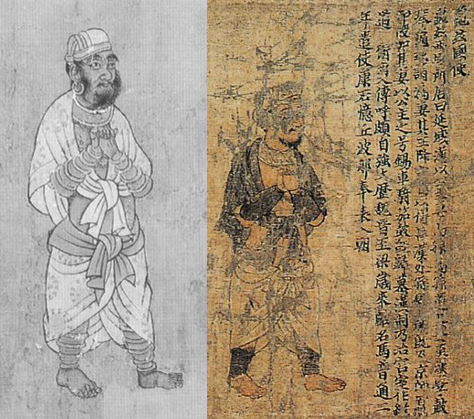
Cover Image: A 6th century Chinese depiction of a Wa (Wo) envoy from Japan (Image Source).
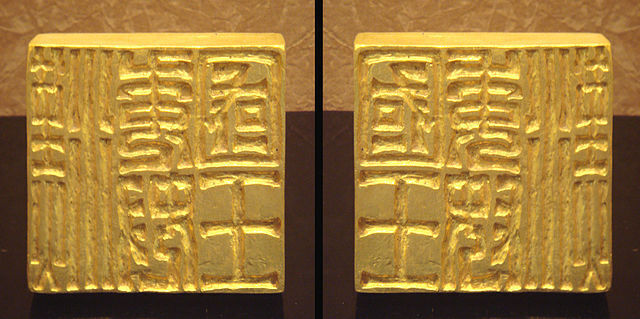
The golden seal, discovered in Kyushu, bearing the same inscriptions as one described in Chinese textual sources that was bestowed upon a Wa (Wo) embassy by Emperor Guangwu of Eastern Han in 57 CE (Image Source).
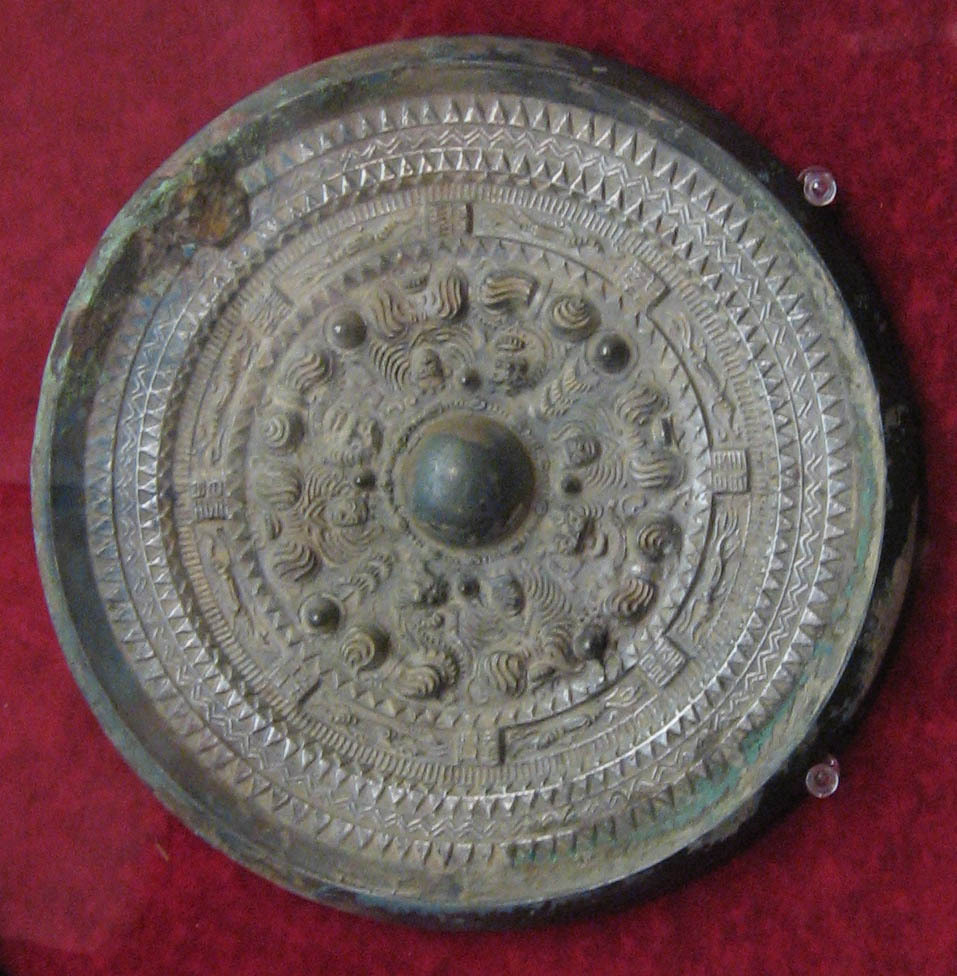
Bronze mirrors (Shinjū-kyō) uncovered in Japan. These mirrors are referenced in Chinese historical sources as gifts to the embassy of Himiko (Image Source).
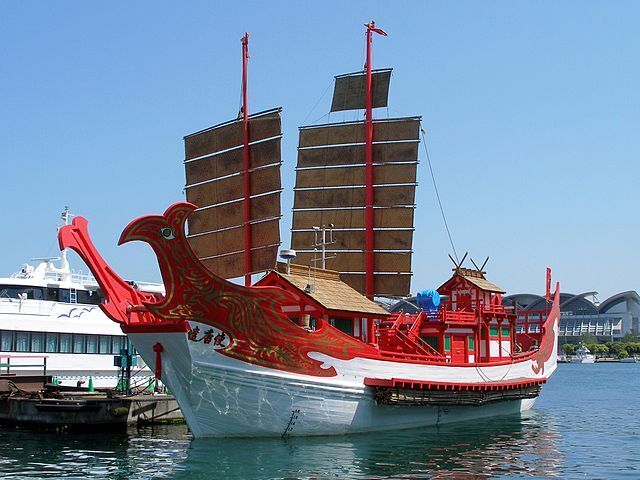
A model of the type of ships that the Japanese dispatched to Tang China (Image Source).
References
Barnes, Gina L. State Formation in Japan: Essays on Yayoi and Kofun Period Archaeology. London: Routledge Curzon, 2003.
Fogel, Joshua A. Japanese Historiography and the Gold Seal of 57 CE: Relic, Text, Object, Fake. Leiden: Brill, 2013.
Holcombe, Charles. The Genesis of East Asia, 221 BC-AD 907. University of Hawai‘i Press, 2001.
Kidder, Edward J. Himiko and Japan's Elusive Chiefdom of Yamatai: Archaeology, History, and Mythology. University of Hawaiʻi Press, 2007.
Saeki, Arikiyo. Treatise on the People of Wa in the Chronicle of the Kingdom of Wei: The World's Earliest Written Text on Japan. Trans. Joshua A. Fogel. Portland: Merwin Asia, 2018.
Sui shu 隋書. Comp. Wei Zheng 魏徵. 85 vols. https://zh.wikisource.org/wiki/隋書.
Suzuki Yasutami 鈴木靖民. “Wa to Chōsen Sankoku to Kaya” 倭と朝鮮三国と加耶. In Nihon kodai kōryūshi nyūmon 日本古代交流史入門, ed. Suzuki Yasutami 鈴木靖民, Kaneko Shūichi 金子修一, Tanaka Fumio 田中史生, and Ri Sonshi 李成市. Bensei Shuppan, 2017.
Wang, Zhenping. Ambassadors from the Islands of Immortals: China-Japan Relations in the Han-Tang Period. University of Hawaiʻi Press, 2005.
Wang, Zhenping. Tang China in Multi-Polar Asia: A History of Diplomacy and War. University of Hawaiʻi Press, 2013.

Thursday Nov 25, 2021
New Perspectives on the Zheng He Voyages: A Conversation with Sean Cronan
Thursday Nov 25, 2021
Thursday Nov 25, 2021
In this episode, Sean talks about some of the new scholarships and perspectives on the famous Zheng He voyages. Zheng He is widely known to history as the eunuch admiral who led several large-scale voyages to Southeast Asia and the Indian Ocean. For many Chinese, the story of Zheng He and his travels to the Indian Ocean (鄭和下西洋) is often seen as a symbol of China's friendship and diplomatic and commercial engagement with Southeast Asian, the Indian Ocean, and east African polities. For many in the West, Zheng He's voyages represent a period in time when China dominated the maritime world. But for both Chinese and Western audiences, the end of the voyages in the 1430s marked the end of China's engagement with the maritime world and is often viewed as the Ming's turn towards isolationism. However, new scholarships have emerged challenging this narrative. Sean discusses how these scholarships have led us to reevaluate the Zheng He voyages and what we can learn about the early Ming and early Ming diplomacy from them.
Disclaimer: We apologize for some of the audio issues in this episode. A few parts may sound a bit distorted.
We're now in the Best 20 Chinese History Podcasts on Feedspot! Check the list out here.
Contributors:
Sean Cronan

Sean Cronan is a Ph.D. student at the University of California, Berkeley. His work focuses on East and Southeast Asian diplomatic encounters from the thirteenth to eighteenth centuries, tracing the development of new shared diplomatic norms following the Mongol conquests of Eurasia, as well as how rulers and scholar-officials in the Ming (1368- 1644) and Qing Dynasties (1644-1911) institutionalized and challenged these new norms. He explores how ideas of multipolarity, regime legitimacy, and the makeup of the interstate order came under debate throughout the Mongol Empire, Ming China, the Qing Empire, Chosŏn Korea, Dai Viet (Northern Vietnam), Japan, the Ayutthaya Kingdom of Thailand, the Pagan Kingdom of Burma, and beyond. He works with sources in Chinese (literary Sinitic), Japanese, Thai, Burmese, Manchu, and Dutch.
Yiming Ha

Yiming Ha is a Ph.D. candidate in the Department of History at the University of California, Los Angeles. His current research is on military mobilization and state-building in China between the thirteenth and seventeenth centuries, focusing on how military institutions changed over time, how the state responded to these changes, the disconnect between the center and localities, and the broader implications that the military had on the state. His project highlights in particular the role of the Mongol Yuan in introducing an alternative form of military mobilization that radically transformed the Chinese state. He is also interested in military history, nomadic history, comparative Eurasian state-building, and the history of maritime interactions in early modern East Asia. He received his BA from UCLA and his MPhil from the Hong Kong University of Science and Technology.
Credits
Episode No. 2
Release date: November 13, 2021
Recording location: Los Angeles/Berkeley, CA
Bibliography courtesy of Sean and Yiming
Images
Cover Image: Statue of Zheng He in Malacca, Malaysia (Image Source)

A map of Zheng He's voyages (Image Source).

Zheng He's treasure ship vs. Columbus's ship. Photograph by Lars Plougmann (Image Source).
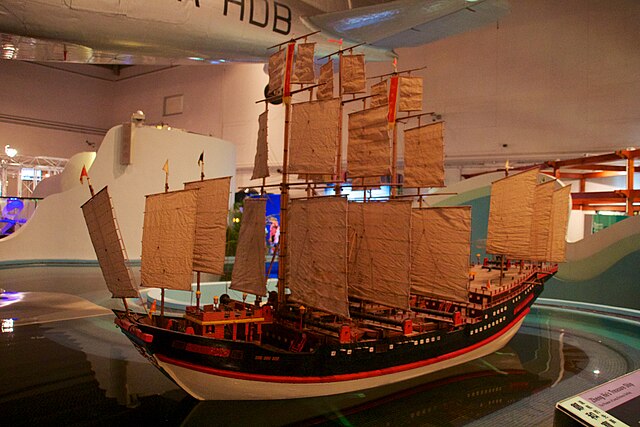
Another model of one of Zheng He's treasure ships. The Hong Kong Science Museum (Image Source).
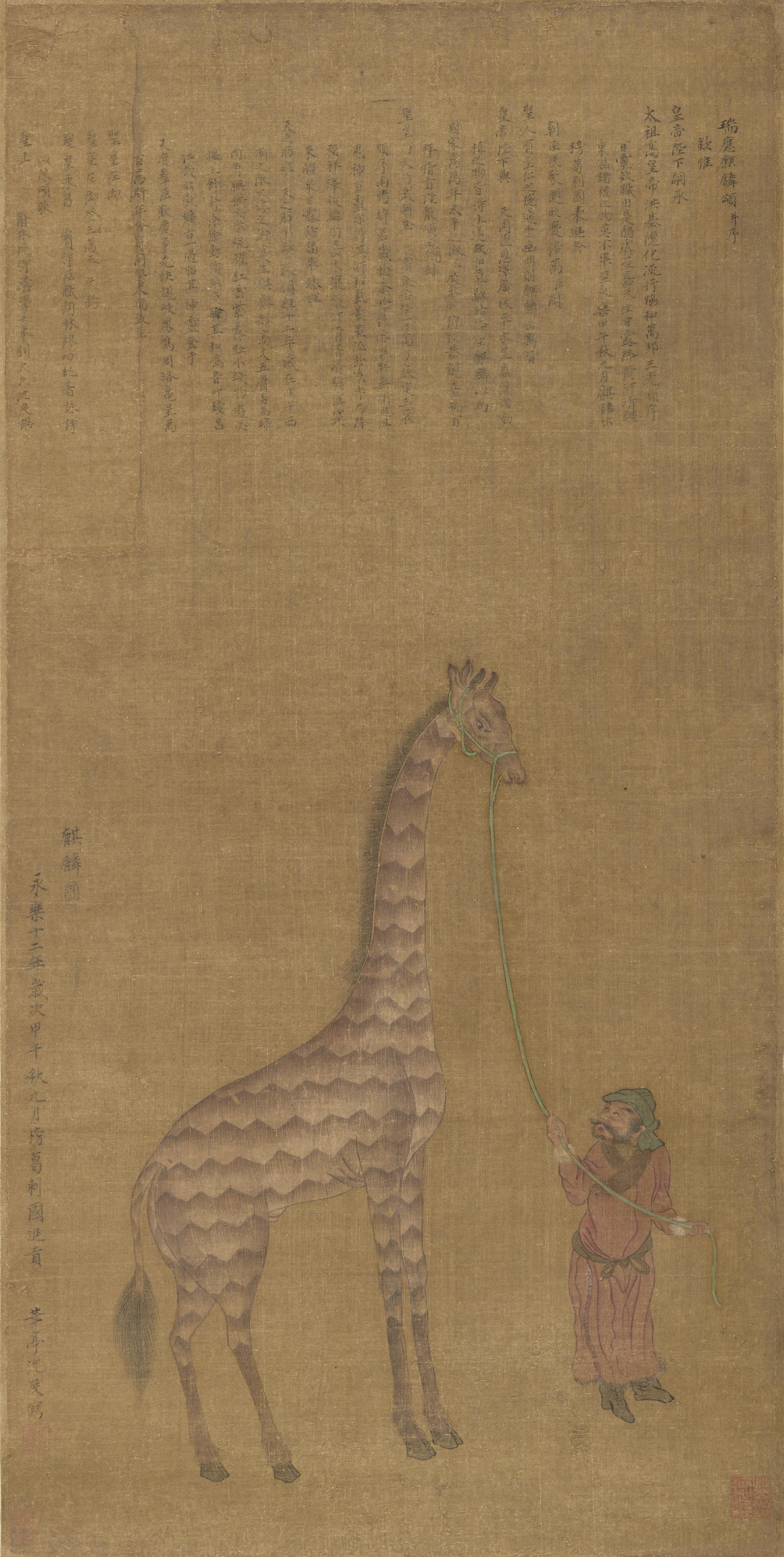
Tribute Giraffe with Attendant 瑞應麒麟圖 (1414) by Shen Du (沈度, 1357–1434), currently held in the National Palace Museum in Taipei (Image Source).
Select Bibliography

Sunday Oct 31, 2021
Sunday Oct 31, 2021
In our very first episode, Greg talks about some aspects of his research on the growing role of Chinese merchants in the East Asian sea trade between the 10th to 12th centuries. Diplomacy from the 7th to 9th centuries was dominated by official embassies that neighboring states dispatched to the Sui-Tang courts, but after the fall of the Tang dynasty in the early 10th century, private merchants from southeastern China began to dominate the maritime trading routes to Japan, Korean, and Southeast Asia. Greg shares with us some information about why that came to be, where these merchants came from, where they show up in the textual records, and some of the implications that this had for Sino-Japanese relations.
We apologize for some of the audio quality in this episode. We are just starting out and we are working to improve our audio quality!
Contributors:
Greg Sattler

Gregory Sattler is a Ph.D. student in the Department of History at the University of California, Los Angeles. His research focuses on sea merchants in East Asia from the ninth to thirteenth centuries, with a particular consideration of their place in society, their trade networks, and their relationships with government officials. Gregory has recently published an article titled “The Ideological Underpinnings of Private Trade in East Asia, ca. 800–1127” (Journal of Asian Humanities at Kyushu University 6) and he is currently working on two additional manuscripts. He has received degrees in Taiwan and Japan, and is a proficient speaker of both Chinese and Japanese.
Yiming Ha

Yiming Ha is a Ph.D. candidate in the Department of History at the University of California, Los Angeles. His current research is on military mobilization and state-building in China between the thirteenth and seventeenth centuries, focusing on how military institutions changed over time, how the state responded to these changes, the disconnect between the center and localities, and the broader implications that the military had on the state. His project highlights in particular the role of the Mongol Yuan in introducing an alternative form of military mobilization that radically transformed the Chinese state. He is also interested in military history, nomadic history, comparative Eurasian state-building, and the history of maritime interactions in early modern East Asia. He received his BA from UCLA and his MPhil from the Hong Kong University of Science and Technology.
Credits
Episode No. 1
Release date: October 31, 2021
Recording location: Los Angeles, CA
Bibliography courtesy of Greg

Tōjin sōbetsushi narabini sekitoku 唐人送別詩幷尺牘 (Chinese Farewell Poems and Writings). From the Onjō-ji collections 園城寺蔵, currently held in the Nara National Museum 奈良国立博物館.
Select Bibliography

